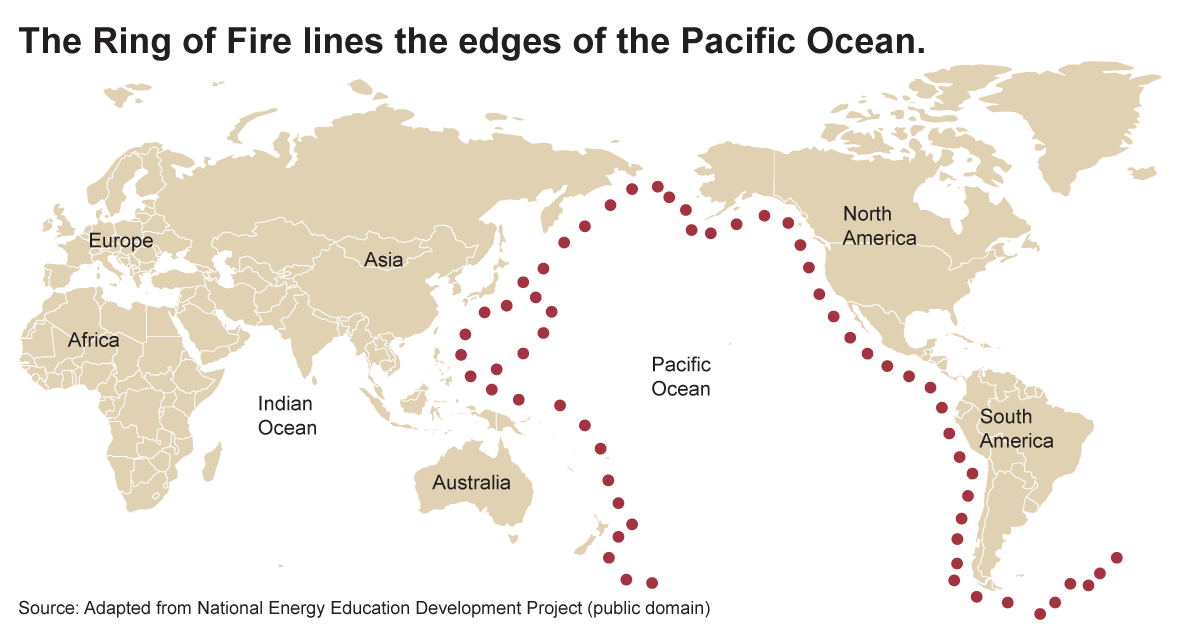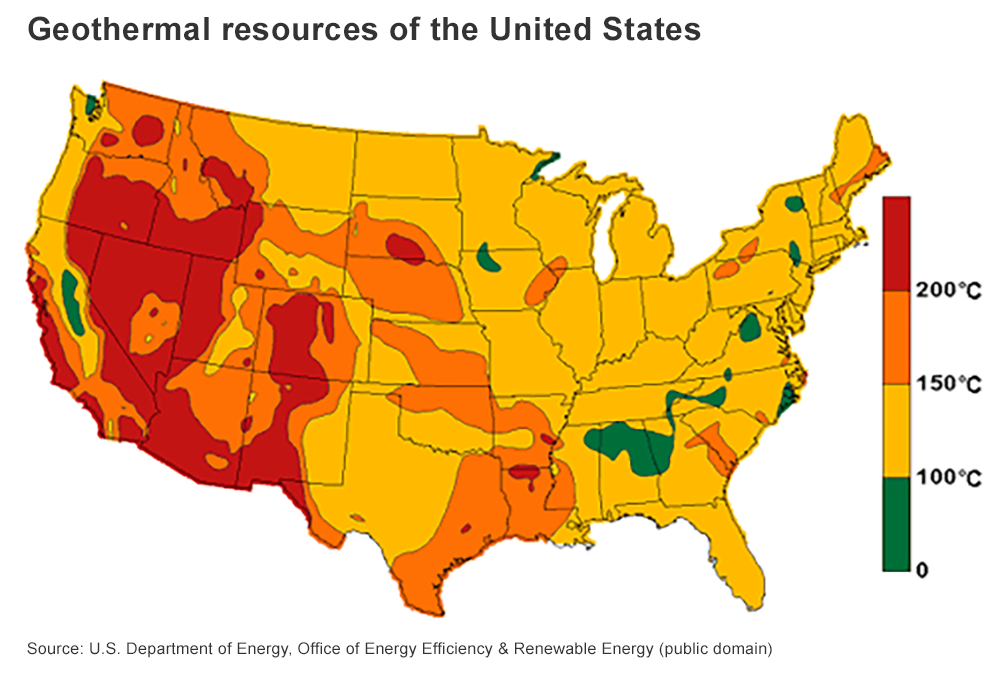Geothermal basics
What is geothermal energy?
Geothermal energy is heat within the earth. The word geothermal comes from the Greek words geo (earth) and therme (heat). Geothermal energy is a renewable energy source because heat is continuously produced inside the earth. People use geothermal heat for bathing, to heat buildings, and to generate electricity.
Geothermal energy comes from deep inside the earth
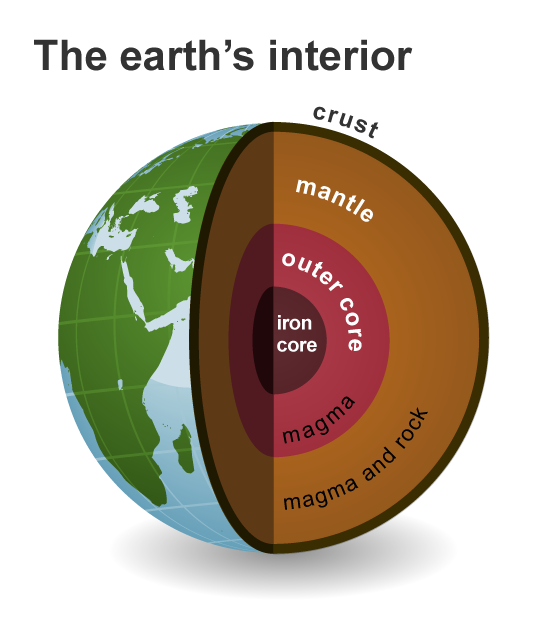
Source: Adapted from a National Energy Education Development Project graphic (public domain)
The slow decay of radioactive particles in the earth's core, a process that happens in all rocks, produces geothermal energy.
The earth has four major parts or layers:
- An inner core of solid iron that is about 1,500 miles in diameter
- An outer core of hot molten rock called magma that is about 1,500 miles thick.
- A mantle of magma and rock surrounding the outer core that is about 1,800 miles thick
- A crust of solid rock that forms the continents and ocean floors that is 15 to 35 miles thick under the continents and 3 to 5 miles thick under the oceans
Scientists have discovered that the temperature of the earth's inner core is about 10,800 degrees Fahrenheit (°F), which is as hot as the surface of the sun. Temperatures in the mantle range from about 392°F at the upper boundary with the earth's crust to approximately 7,230°F at the mantle-core boundary.
The earth's crust is broken into pieces called tectonic plates. Magma comes close to the earth's surface near the edges of these plates, which is where many volcanoes occur. The lava that erupts from volcanoes is partly magma. Rocks and water absorb heat from magma deep underground. The rocks and water found deeper underground have the highest temperatures.
Where geothermal energy is found
Geothermal reservoirs are naturally occurring areas of hydrothermal resources. These reservoirs are deep underground and are largely undetectable above ground. Geothermal energy finds its way to the earth's surface in three ways:
- Volcanoes and fumaroles (holes in the earth where volcanic gases are released)
- Hot springs
- Geysers
Most geothermal resources are near the boundaries of the earth’s tectonic plates
The most active geothermal resources are usually found along major tectonic plate boundaries where most volcanoes are located. One of the most active geothermal areas in the world is called the Ring of Fire, which encircles the Pacific Ocean.
When magma comes near the earth's surface, it heats ground water trapped in porous rock or water running along fractured rock surfaces and faults. Hydrothermal features have two common ingredients: water (hydro) and heat (thermal).
Geologists use various methods to find geothermal reservoirs. Drilling a well and testing the temperature deep underground is the most reliable method for locating a geothermal reservoir.
U.S. geothermal power plants are located in the West
Most of the geothermal power plants in the United States are in western states and Hawaii, where geothermal energy resources are close to the earth's surface. California generates the most electricity from geothermal energy. The Geysers dry steam reservoir in Northern California is the largest known dry steam field in the world and has been producing electricity since 1960.
Use of geothermal energy
Some applications of geothermal energy use the earth's temperatures near the surface, while others require drilling miles into the earth. There are three main types of geothermal energy systems:
- Direct use and district heating systems
- Electricity generation power plants
- Geothermal heat pumps
Direct use and district heating systems
Direct use and district heating systems use hot water from springs or reservoirs located near the surface of the earth. Ancient Roman, Chinese, and Native American cultures used hot mineral springs for bathing, cooking, and heating. Today, many hot springs are still used for bathing, and many people believe the hot, mineral-rich waters have natural healing powers.
Geothermal energy is also used to heat buildings through district heating systems. Hot water near the earth's surface is piped directly into buildings for heat. A district heating system provides heat for most of the buildings in Reykjavik, Iceland.
Industrial applications of geothermal energy include food dehydration, gold mining, and milk pasteurizing. Dehydration, or the drying of vegetable and fruit products, is the most common industrial use of geothermal energy.
Geothermal electricity generation
Geothermal electricity generation requires water or steam at high temperatures (300° to 700°F). Geothermal power plants are generally built where geothermal reservoirs are located, within a mile or two of the earth's surface.
The United States leads the world in the amount of electricity generated with geothermal energy. In 2021, there were geothermal power plants in seven states, which produced about 16 billion kilowatthours (kWh), equal to 0.4% of total U.S. utility-scale electricity generation.
| State share of total U.S. geothermal electricity generation | Geothermal share of total state electricity generation | |
|---|---|---|
| California | 69.5% | 5.8% |
| Nevada | 24.2% | 9.6% |
| Utah | 2.7% | 1.2% |
| Hawaii | 1.8% | 3.2% |
| Oregon | 1.2% | 0.3% |
| Idaho | 0.5% | 0.5% |
| New Mexico | 0.3% | 0.1% |
In 2021, 27 countries, including the United States, generated a total of about 92 billion kWh of electricity from geothermal energy. Indonesia was the second-largest geothermal electricity producer after the United States—nearly 16 billion kWh of electricity—and equal to 5% of Indonesia’s total electricity generation. Kenya was the eighth-highest geothermal electricity producer at about 5 billion kWh. This was equal to about 43% of Kenya's annual electricity generation, which was the largest percentage share among all countries with geothermal power plants.
Geothermal heat pumps
Geothermal heat pumps use the constant temperatures near the surface of the earth to heat and cool buildings. Geothermal heat pumps transfer heat from the ground (or water) into buildings during the winter and reverse the process in the summer.
Geothermal power plants
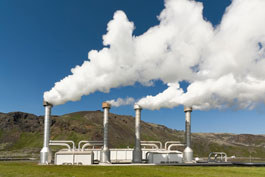
Source: Stock photography (copyrighted)
Geothermal power plants use hydrothermal resources that have both water (hydro) and heat (thermal). Geothermal power plants require high-temperature (300°F to 700°F) hydrothermal resources that come from either dry steam wells or from hot water wells. People use these resources by drilling wells into the earth and then piping steam or hot water to the surface. The hot water or steam powers a turbine that generates electricity. Some geothermal wells are as much as two miles deep.
Types of geothermal power plants
There are three basic types of geothermal power plants:
- Dry steam plants use steam directly from a geothermal reservoir to turn generator turbines. The first geothermal power plant was built in 1904 in Tuscany, Italy, where natural steam erupted from the earth.
- Flash steam plants take high-pressure hot water from deep inside the earth and convert it to steam to drive generator turbines. When the steam cools, it condenses to water and is injected back into the ground to be used again. Most geothermal power plants are flash steam plants.
- Binary cycle power plants transfer the heat from geothermal hot water to another liquid. The heat causes the second liquid to turn to steam, which is used to drive a generator turbine.
Geothermal heat pumps
Geothermal heat pumps use the earth's constant temperatures for heating and cooling
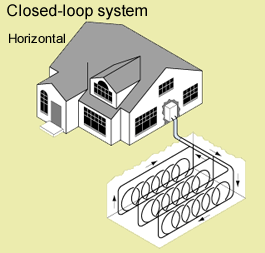
Source: U.S. Department of Energy, Office of Energy Efficiency and Renewable Energy (public domain)
Although air temperatures above ground change throughout the day and with the seasons, temperatures of the earth 10 feet below ground are consistently between 50°F and 60°F. For most areas of the United States, this means soil temperatures are usually warmer than the air in winter and cooler than the air in summer. Geothermal heat pumps use the earth's constant temperature to heat and cool buildings. Geothermal heat pumps transfer heat from the ground (or water) into buildings during the winter and reverse the process in the summer.
Geothermal heat pumps are energy efficient and cost effective
According to the U.S. Environmental Protection Agency (EPA), geothermal heat pumps are the most energy-efficient, environmentally clean, and cost-effective systems for heating and cooling buildings. All types of buildings, including homes, office buildings, schools, and hospitals, can use geothermal heat pumps.
Geothermal energy and the environment
The environmental effects of geothermal energy depend on how geothermal energy is used or how it is converted to useful energy. Direct use applications and geothermal heat pumps may have a very small effect on the environment. In fact, they may reduce the use of energy sources that may have larger effects on the environment.
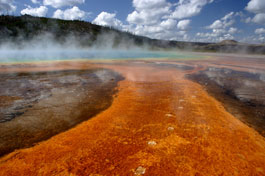
Source: Stock photography (copyrighted)
Geothermal power plants have low emission levels
Geothermal power plants do not burn fuel to generate electricity, but they may release small amounts of sulfur dioxide and carbon dioxide. Geothermal power plants emit 97% less acid rain-causing sulfur compounds and about 99% less carbon dioxide than fossil fuel power plants of similar size. Geothermal power plants use scrubbers to remove the hydrogen sulfide naturally found in geothermal reservoirs. Most geothermal power plants inject the geothermal steam and water that they use back into the earth. This water recycling can help to maintain the geothermal energy resource.
Many geothermal features are national treasures
Geothermal features in national parks, such as geysers and fumaroles in Yellowstone National Park, are protected by law.


